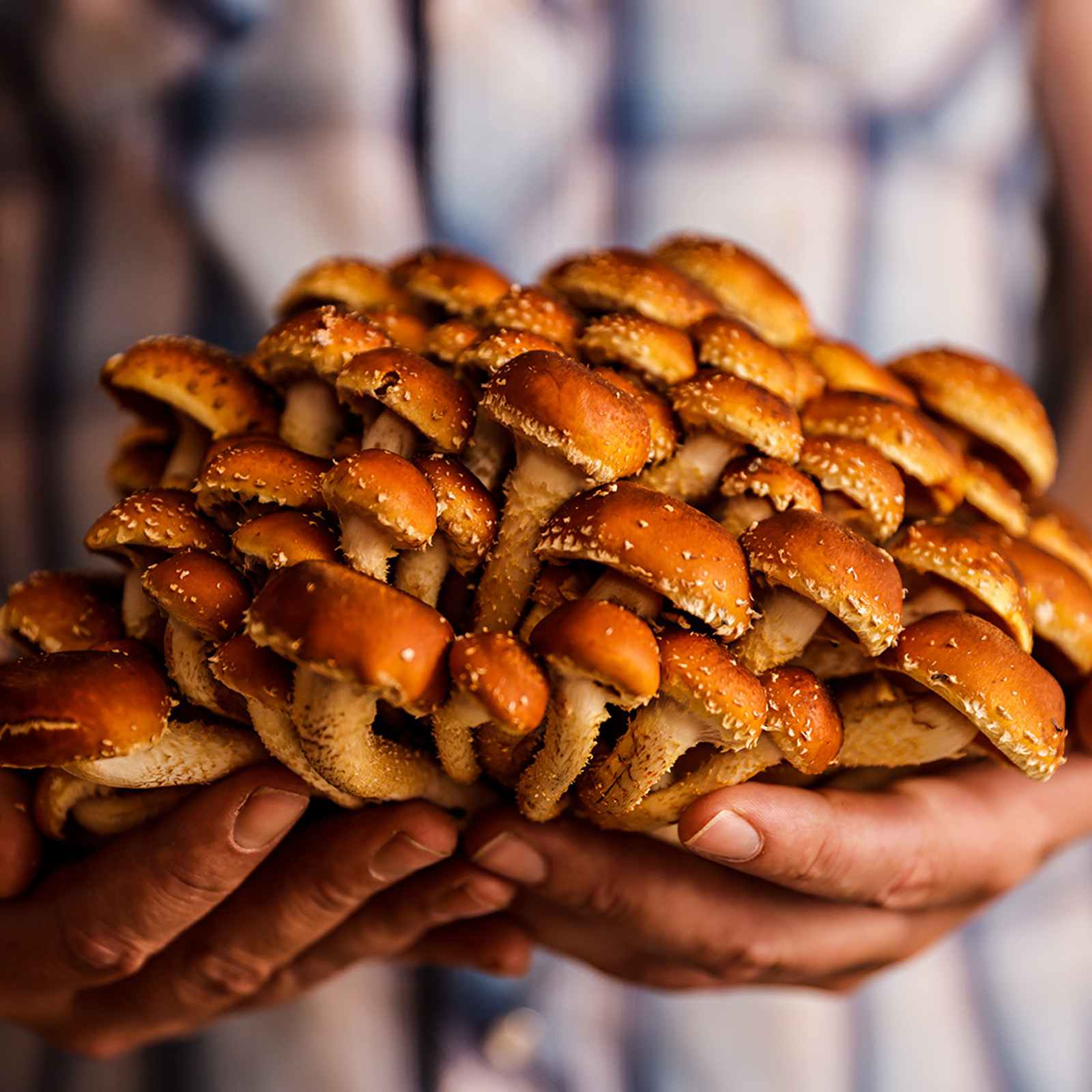For Shawn McDyre, the path to enjoying mushrooms in a meal can be as simple as a good piece of bread, some Black Pearl King mushrooms and a few pantry staples.
In terms of flavor, McDyre said he compares the Black Pearls, a kind of hybrid oyster mushroom, to another type, the porcini, which is known for its rich, meat-like flavor that’s sometimes described as both earthy and nutty. To suit McDyre’s tastes, slicing the thick stems of the Black Pearl Kings into thin strips like bacon and salting them is a prelude to browning them in a pan with some butter, before spreading them over the bread.
It’s a satisfying, protein-dense snack, or even a meal, and it’s just one of the many ways the unique varieties of mushrooms grown at Sun Hands Farm can be incorporated into the daily rhythms of a home kitchen.
From the front, the grow building at Sun Hands Farm, which is the name of the gourmet mushroom farm that McDyre and his wife, Jennifer, own, looks like an unremarkable cross between an accessory dwelling and a double-wide. But to walk inside of this simple, single-story rectangular building on the outskirts of Kalispell is to briefly walk into what might be mistaken for another world entirely, where flavor grows in shapes and designs that seem to defy imagination.
On a recent visit, stepping into the cool interior of the heart of Sun Hands Farm reveals little. McDyre keeps the lights dim, the décor sparse, and the temperature cool. The reason why lies a few feet from the door, inside a medium-sized room with translucent walls, where clouds of mist pulsate over shelves lined with the fruits — or, rather, fungi — of McDyre’s labor. The most striking from a distance are the oyster mushrooms, which grow in cascading tiers like water fountain fixtures. But up close, it’s the Lion’s Mane mushrooms —white globes covered in thin, almost hair-like tendrils — that most seem to defy possibility.
This is the fruiting room, where shiitakes, chestnut, oyster, pioppino, Black Pearl Kings, and Lion’s Mane mushrooms have their growth accelerated after their grain colonized with mycelium have spent weeks in the dark feeding off substrate bags of sterilized blocks of wood pellets and soy hulls wrapped in plastic.
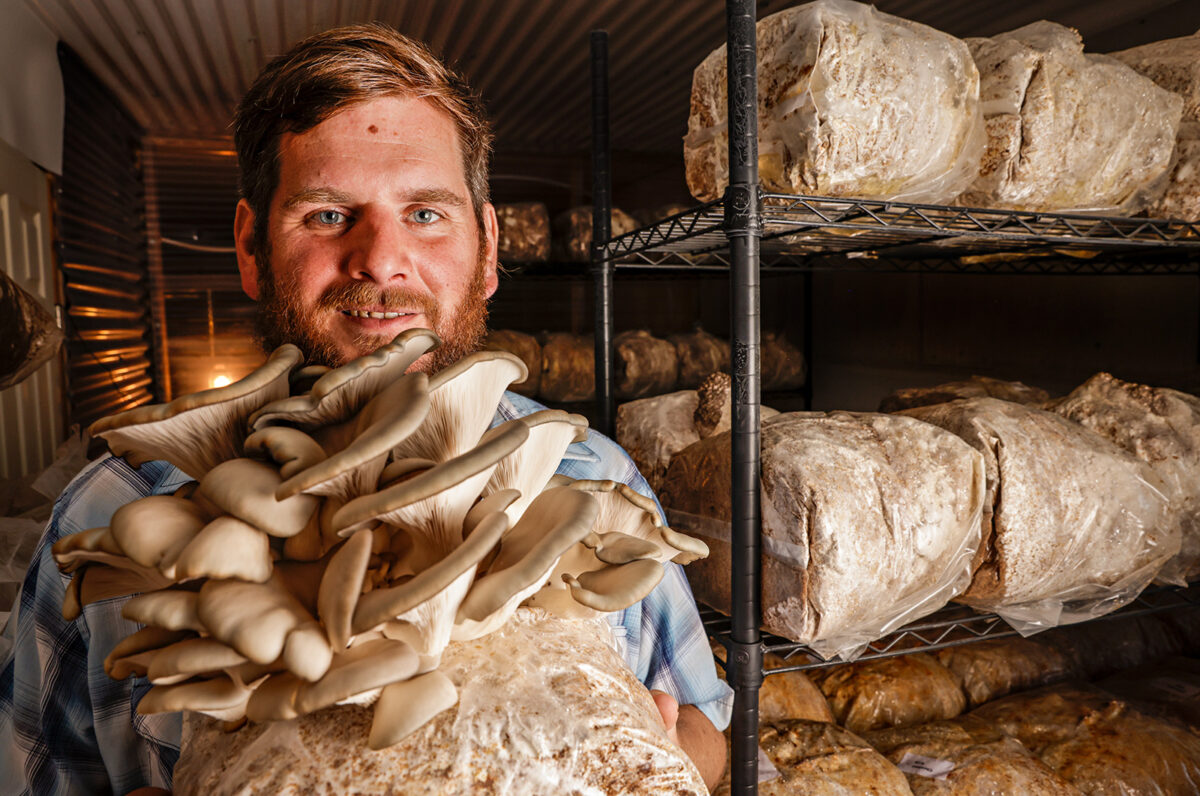
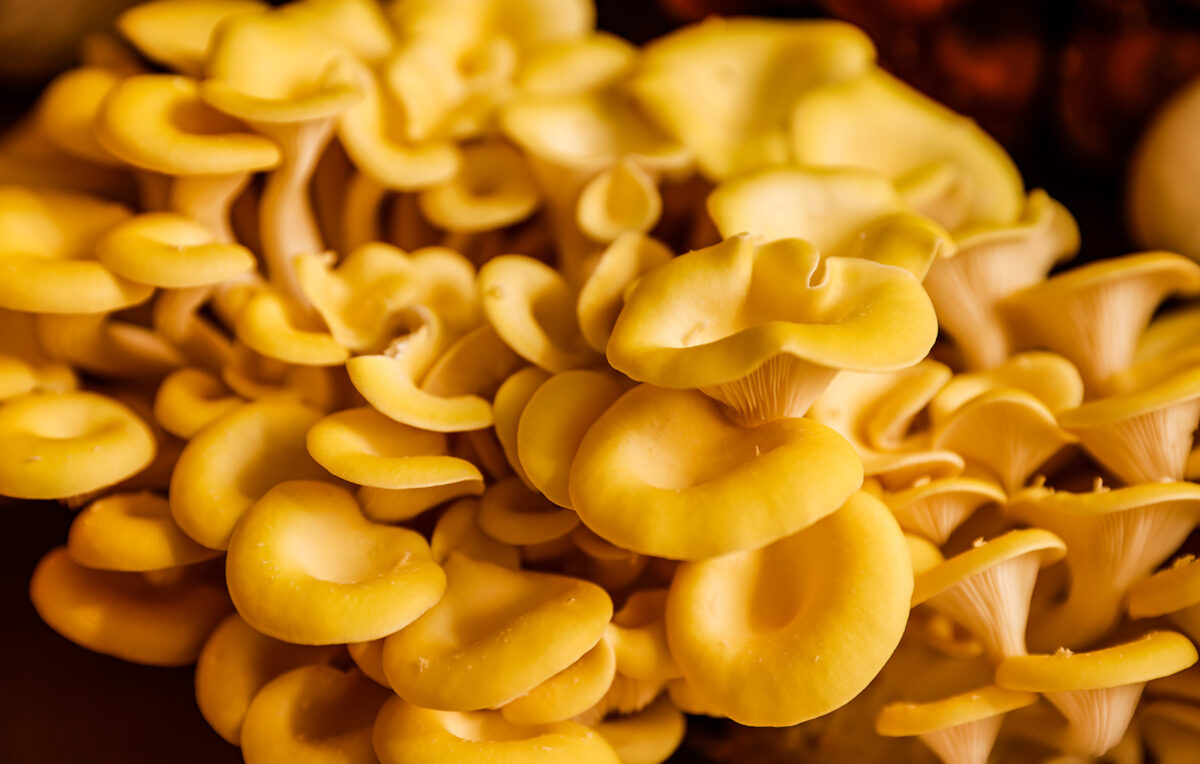
Cultivating mushrooms isn’t a simple process, and the conditions in the fruiting room that McDyre wants to create have to be exact, or else the entire crop can be ruined. That’s why he has a separate, cooler incubating room for the earlier-stage mushrooms that’s cool, dark, and insulated from what’s going on in the nearby fruiting room.
“It’s a constant battle of fighting the environment that’s in there,” McDyre said. But it’s a battle, and a challenge, that hits the sweet spot for his interests. An engineer by trade, with a longtime fascination with fermenting, homebrewing, microbiology, and gardening, McDyre said his work at Sun Hands represents a marriage of all those different interests. And of course, it is part of his marriage, too.
Jennifer McDyre, who met Shawn in their hometown of Philadelphia in 2012 and married him in 2017, also helps run the business. The early days before Sun Hands was up and running had a comical, if a bit maddening, feel to them. Shawn started experimenting with growing mushrooms back when the couple lived in Billings. Substrate bags with growing mushrooms couldn’t be stored in custom-built incubation or fruiting rooms. Instead, they lived in the McDyres’ garage, but sometimes found their way into Jennifer’s closet, or had a seat in the car on vacations.
“We got to the point where we were legitimately arguing over whether or not it was okay for my clothing closet to be a quarter-filled with essentially that room,” Jennifer said, gesturing to the Sun Hands incubating room.
Laughing, she said that it worked out in the end, and that what they have now is Shawn’s dream scenario.
“We started from the most ridiculously humble roots imaginable,” she said.
Whatever fascination Shawn McDyre held for growing mushrooms has since spread throughout the Flathead Valley. When the McDyres started Sun Hands in 2018, they had the capacity to grow between 40 and 50 pounds of mushrooms a week, which were often sold at farmer’s markets. In some cases, wolfish customers would buy out their entire stock before the rest of the market even opened. Now, Shawn estimates he can grow between 400 and 500 pounds a week, but people are still left wanting more.
“We’ve never been able to keep up, and I don’t prefer it that way to not having enough to satisfy everyone’s needs,” Shawn said. “It’s just grown. Mushrooms took off … and became super popular.” In his view, some of that popularity seems to be driven by a wider availability of more niche types of mushrooms, coupled with a growing interest in both the health benefits and psychedelic uses of certain kinds of mushrooms. Research has shown that incorporating mushrooms into a regular diet can reduce the risk of cancer, improve gut and brain health, and offer a good source of a number of vitamins and other nutrients. They’re also a great source of protein.


“They all range between 18 and 21 percent protein, which is in between eggs and chicken breasts,” McDyre said of his varietals.
As Shawn explains, button mushrooms, cremini mushrooms, and portobellos — the most common grocery store varieties— are all the same species of mushroom, but they’re harvested at different stages in their growth. For most people, that’s all they know.
But a whole other world of flavor exists in the mushrooms grown at Sun Hands. Lion’s Mane, for example, is a popular meat substitute, boasting a flavor that draws comparisons to lobster or crab. Chestnut mushrooms offer a deep, earthy flavor, which Shawn says makes them a good substitute for some of the more difficult-to-acquire mushrooms, such as wild morels and oyster mushrooms.
For people who regularly incorporate mushrooms into their cooking and diets, Sun Hands offers a CSA box, with the option to sign up for weekly full (1 pound) or half orders running on a 12-week cycle. Each week, those who have enrolled in the CSA program can pick up their mushrooms at several locations around the valley. The selection rotates throughout the year, but each box includes at least two types of mushrooms, and draws from varieties including oyster, shiitake, lion’s mane, chestnut and Black Pearl King.
These days, most of Sun Hands business come through contracts with local restaurants who see culinary opportunity in taking advantage of the dynamic range of flavors found in the mushrooms that Sun Hands cultivates.
Over at Herb & Omni, a newly opened restaurant at the former Casey’s location in downtown Whitefish, Executive Sous Chef Shane VanVeldhuizen admits he’s fascinated with mushrooms and what can be achieved with them in the kitchen. VanVeldhuizen previously worked at the Mercantile Steak restaurant in Kalispell, and with his switch to Herb & Omni, he maintained his connection with the McDyres, who now supply the restaurant with a variety of mushrooms, which appear on the menu in a variety of forms.
One of the simplest and most satisfying mushroom pairings at Herb & Omni is alongside one of their locally sourced Wagyu flat iron steaks, served next to a bed of Carolina Gold rice. To start, a variety of mushrooms are lightly oven-roasted with olive oil and salt. A steak is then seared at high heat and basted with herbs and butter. When the steak leaves the skillet, the mushrooms go in, where they’re subjected to high heat and seared.
Once plated, the mushrooms and steak are blanketed in a demi-glace created with mushroom stock, black garlic and black vinegar, and then topped with fresh herbs and pickled fennel, which offers an acidic counterbalance to the heavier, more umami steak-and-mushroom flavors.
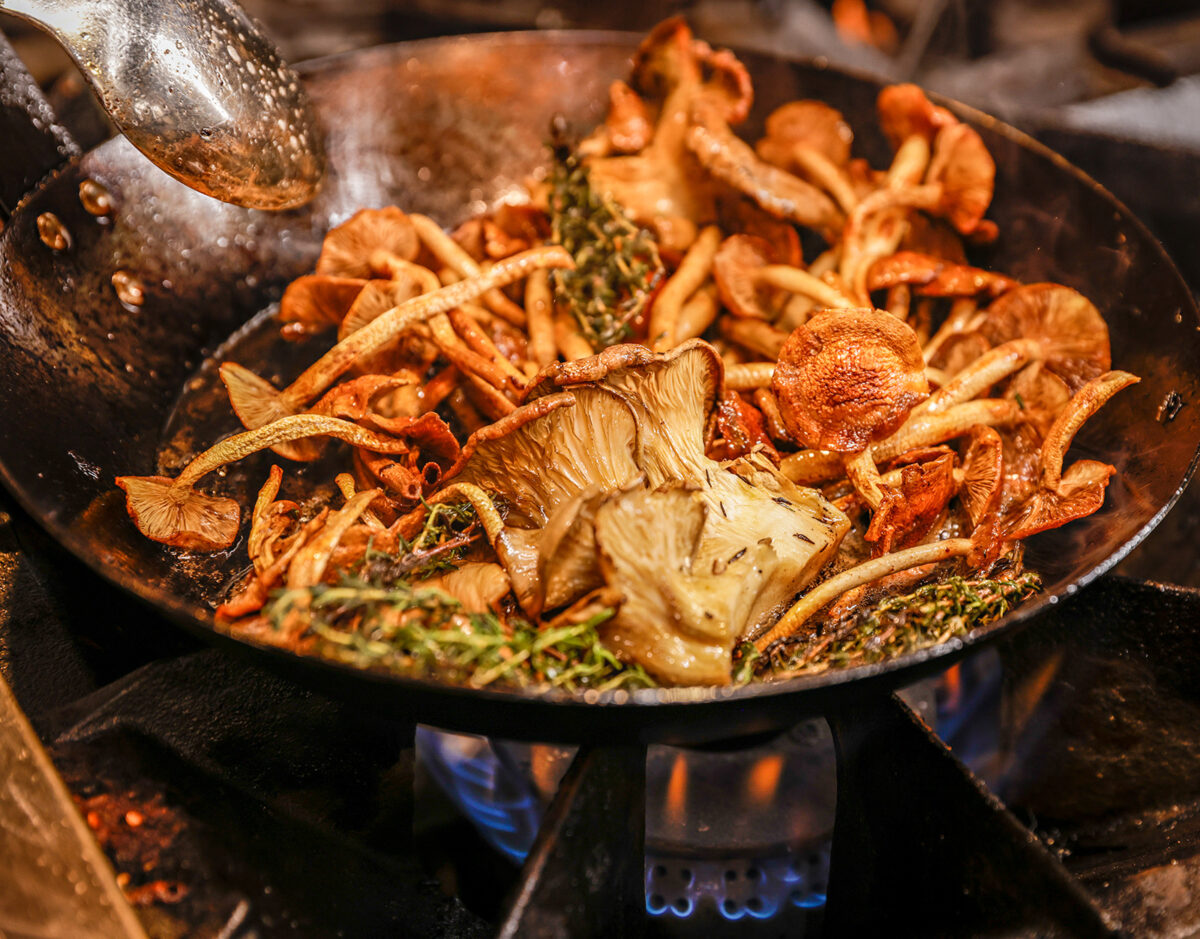
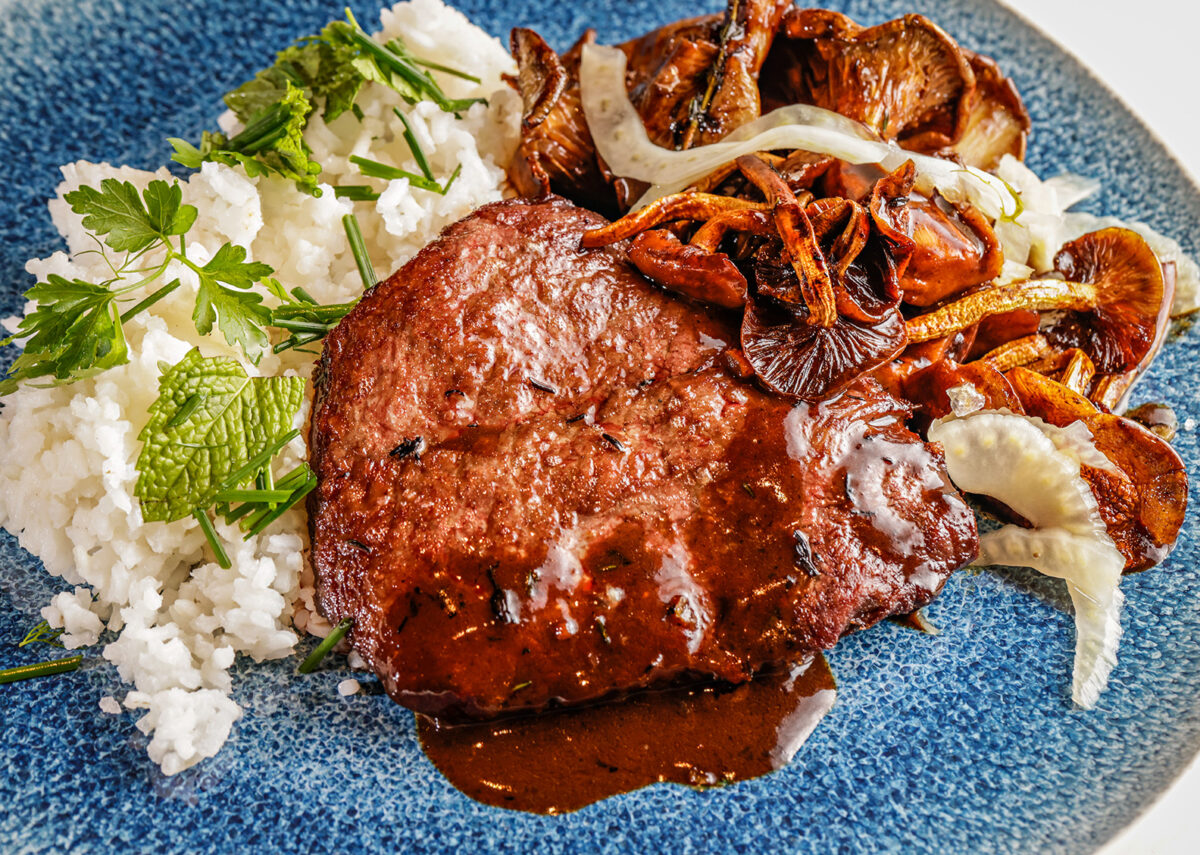
Justin Kingsley Hall, the executive chef at Herb & Omni who designed the menu, said he doesn’t like to use plant-based meat substitutes, and similarly doesn’t believe in hiding vegetables in a dish. Some of those principles tie into the broader idea behind Herb & Omni, as a place where herbivores and omnivores — diners who don’t eat meat, as well as those who eat meat and vegetables, respectively — can come and enjoy a meal together. Part of that approach means treating vegetables, and mushrooms, as something worth showcasing for the quality ingredient that they are without too many alterations.
“I think the biggest thing for home cooks is they need to start doing what chefs do when we get new ingredients in. It’s like the simplest thing, right? A little salt, a little oil, put it in a pan, and then just taste it,” Kingsley Hall said of where to start when it comes to cooking with mushrooms at home.
For Ellie Heyman, one of the culinary minds behind the former Wich Haus restaurant in Whitefish, mushrooms can be a forgiving ingredient. That owes in part to the presence of chitin, a resilient substance similar to keratin (a protein in hair, nails and skin) that’s found in crustaceans, insects and the cells of fungi. Chitin allows mushrooms to be cooked down considerably without them actually breaking down and turning to mush. At the former Wich Haus, Heyman’s Oktoberfest menu featured a crispy pork schnitzel sandwich topped with a mix of cremini and shiitake mushrooms that were seared and then cooked down in pork stock, before being mixed with pickled onion, whole-grain mustard and crème fraiche.
“So, it was kind of like this creamy, rich, cooked-down kind of meaty mushroom braise,” Heyman said, adding that that same mixture, that can also be made with regular chicken stock, goes well in a variety of dishes, including as a topping over egg noodles.
Heyman said that generally, mushrooms respond well to big flavors, and hot dry heat.
“They can take on a lot of flavor,” she said. “Don’t be shy with the seasoning.”
